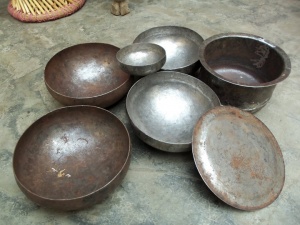Sarbloh: Difference between revisions
Allenwalla (talk | contribs) mNo edit summary |
Allenwalla (talk | contribs) m (although i could not find a video on metal making of Indian swords, these on the methods used in Japan were introduced to China, Japan and the Middle East by artisans from India, even Buddhist monks) |
||
| Line 7: | Line 7: | ||
Sarbloh should not be confused with either cast iron or steel as these metals only came into common use during the industrial revolution of the 19th century. | Sarbloh should not be confused with either cast iron or steel as these metals only came into common use during the industrial revolution of the 19th century. | ||
It is thought that iron was first produced in India, along the Indus river. Possibly trying to reproduce the chunks of metal that are even today found in the world's desserts or lumps of iron produced by lightening strikes (which also produce glass and ignite fires) artisans were producing iron ore mixed with charcoal in ancient forges using forced air (from bellows). First a lump of iron (also called bum steel today) was produced. When enough raw iron had been produced it could be reheated and then hammered out to the shape required; a knife, sword, tool or pan such as a Bata. Artisans in today's Panjab and Gujerat areas were producing carbon laden billets of raw iron that were highly prized by the sword makers in the middle east long before the metal came to be known by the terms Watered | It is thought that iron was first produced in India, along the Indus river. Possibly trying to reproduce the chunks of metal that are even today found in the world's desserts or lumps of iron produced by lightening strikes (which also produce glass and ignite fires) artisans were producing iron ore mixed with charcoal in ancient forges using forced air (from bellows). First a lump of iron (also called bum steel today) was produced. When enough raw iron had been produced it could be reheated and then hammered out to the shape required; a knife, sword, tool or pan such as a Bata. Artisans in today's Panjab and Gujerat areas were producing carbon laden billets of raw iron that were highly prized by the sword makers in the middle east long before the metal came to be known by the terms Watered or Damascus steel). This 'steel' should not be confused with the steel blades, cars or frying pans of today, made possible by production processes of the late nineteenth century. | ||
Three videos on smelting iron and producing metals before the nineteenth century: | |||
* (using an electric fan) on making iron: http://www.youtube.com/watch?v=9IBFRy7GTaY | |||
* Making Steel from dirt, http://www.youtube.com/watch?v=gDy1jx6mLgs&feature=related | |||
* Instructive video on metal making as used in the early swords of India and Japan, http://www.youtube.com/watch?v=wDbg1aikq1I | |||
==see also== | ==see also== | ||
Revision as of 01:07, 2 January 2011
Sarbloh (wrought iron) is the metal used in the Bata (a bowl or cauldron) used by Guru Gobind Singh Ji to prepare the Amrit during the Khalsa initiation ceremony in 1699. The Khanda (a double edged knife or sword) was also made of Sarbloh. To this day all Amrit Sanchaars are conducted using a bata and khanda made of sarbloh.
Kara and Kirpan (2 of the Five Ks that a Sikh keeps on his or her person at all times) must also be made of Sarbloh.
Sarbloh should not be confused with either cast iron or steel as these metals only came into common use during the industrial revolution of the 19th century.
It is thought that iron was first produced in India, along the Indus river. Possibly trying to reproduce the chunks of metal that are even today found in the world's desserts or lumps of iron produced by lightening strikes (which also produce glass and ignite fires) artisans were producing iron ore mixed with charcoal in ancient forges using forced air (from bellows). First a lump of iron (also called bum steel today) was produced. When enough raw iron had been produced it could be reheated and then hammered out to the shape required; a knife, sword, tool or pan such as a Bata. Artisans in today's Panjab and Gujerat areas were producing carbon laden billets of raw iron that were highly prized by the sword makers in the middle east long before the metal came to be known by the terms Watered or Damascus steel). This 'steel' should not be confused with the steel blades, cars or frying pans of today, made possible by production processes of the late nineteenth century.
Three videos on smelting iron and producing metals before the nineteenth century:
- (using an electric fan) on making iron: http://www.youtube.com/watch?v=9IBFRy7GTaY
- Making Steel from dirt, http://www.youtube.com/watch?v=gDy1jx6mLgs&feature=related
- Instructive video on metal making as used in the early swords of India and Japan, http://www.youtube.com/watch?v=wDbg1aikq1I
see also
References
<References>

